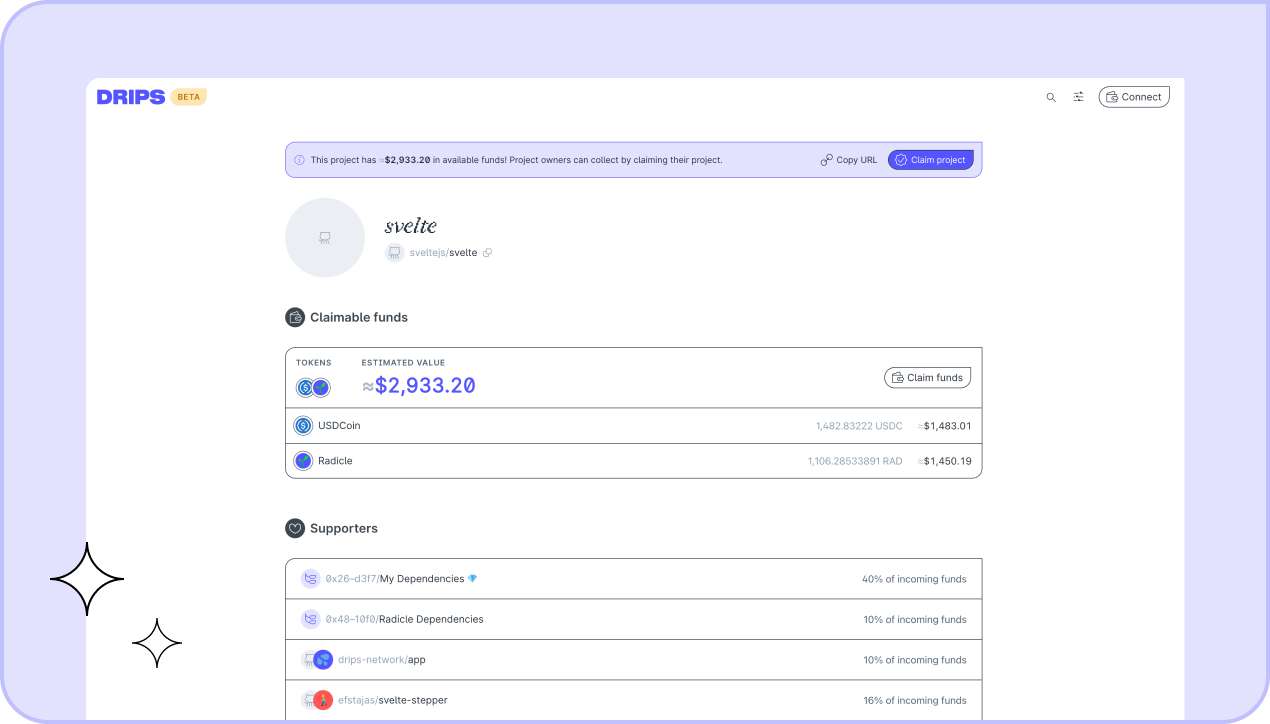Claim your open-source project
A Project on Drips represents an open-source repository on GitHub, with support for other Git hosts coming soon. Every GitHub repository starts out on Drips as unclaimed. In this state, it can already be funded with a Drip List, or added as a dependency of another project. At any point, the project's maintainers can claim their project on Drips, configure a list of maintainers and dependencies, and collect any previously-received earnings. Future incoming funds are then automatically split as configured by the project maintainers, resulting in deeply-nested dependencies receiving their allocation.
Want to claim your project for Drips for Privacy? Make sure you're using the Optimism deployment of the Drips app.
How funds reach projects
Using the Drips app, individuals or organizations wishing to financially support their dependencies can do so with a Drip List. Funds sent to Drip Lists are automatically split among those listed (projects, Ethereum addresses, or other Drip Lists) monthly, on the last Thursday of every month. When funds reach a project from a Drip List, they are further split according to the project's dependencies and maintainers, resulting in a global, fundable dependency tree.

Your repository on Drips
To find your repository's associated "project" on Drips, simply launch the Drips App, paste its GitHub URL into the search bar, and click Jump to GitHub repo. On the resulting project screen, you can see whether your project already accumulated any claimable funds, and quickly jump into the claim process by clicking Claim project.

How Drips manages project access
Drips is built on Ethereum, a global, decentralized blockchain. On Drips, every claimed project is owned by an Ethereum address. You can learn more about Ethereum and create your own personal Ethereum address by downloading and installing an Ethereum wallet app.
As part of the claim process, the on-chain Drips Smart Contracts ensure that a particular Ethereum address should be able to manage a project and its funds by checking whether its default branch on GitHub includes a FUNDING.json file in the root directory. Because Smart Contracts cannot just access the internet, Drips uses an Oracle service to fetch the FUNDING.json file.

The FUNDING.json file includes an Ethereum address, which will subsequently be granted access to the repository on Drips. Your real FUNDING.json file will include your own Ethereum address, and will automatically be generated for you as part of the claiming process.
Access is managed separately for different chains, for example Filecoin. For example, below the same placeholder address has access to the project on Ethereum and Filecoin networks.
{
"drips": {
"ethereum": {
"ownedBy": "0x0000000000000000000000000000000000000000"
},
"filecoin": {
"ownedBy": "0x0000000000000000000000000000000000000000"
}
}
}Claiming your project
You can enter the claim process by launching the Drips App, connecting your Ethereum wallet, and navigating to Projects → Claim project. As part of the flow, you'll be asked to commit a FUNDING.json file to the repository's default branch. If in order to do so you need to wait for a PR to be reviewed, you can simply resume the flow later.
Once the FUNDING.json file has been verified, you'll be asked to configure a list of maintainers and dependencies that incoming funds will be split to, and customize your project's appearance on Drips.
After you're done, your project will be claimed, and any future earnings will be split according to your configuration.

Editing your project
You can edit your project's appearance and split configuration at any point in the future by navigating to it from the Projects tab, and clicking Edit on the thing you'd like to change.
Collecting earnings
If your project already has claimable funds, the claim process will immediately apply the percentage splits to maintainers and dependencies you set up. If you yourself received a portion of the claimable funds, you will be able to immediately transfer them to your Ethereum wallet by clicking Collect on the top right.
Settlement of future funds
Funds in the global Drips Dependency Tree are automatically split accordingly:
- On Ethereum, once per month on every last Thursday, resulting in monthly settlement.
- On Filecoin, once per day, resulting in daily settlement.
- On OP Mainnet, once per day, resulting in daily settlement.
This means that once a project is claimed, funds may reach your project monthly or daily, and will automatically be forwarded according to your configured splits to maintainers and dependencies.
The exact time at which settlement will occur on the indicated day may vary due to gas cost optimization measures.
You can at any point review the next settlement day in the app's Collect modal, but please note that the settlement doesn't occur exactly at midnight, but rather at some point throughout the indicated day, roughly within the UTC time zone.
If you are a recipient of funding on Drips, you can check for and collect any earnings by clicking "Collect" in the top-right corner after connecting your wallet.